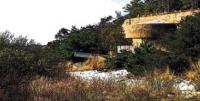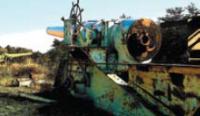By Dr. Gary D. Wray, President, Fort Miles Historical Association Photos by Steve Rogers
In 1940 the United States military began the engineering process to establish a huge fortification at the mouth of the Delaware Bay at Lewes to protect the Atlantic Ocean approaches to the critical Philadelphia area from our enemies. Over the next two years one of the most powerful forts in the world was built here. It included some of the biggest guns in any coastal fortification.
 Fort Miles ultimately included over 1,500 acres and stretched from little Lewes south to Rehoboth Beach and beyond, and included areas across the Delaware Bay at Cape May, New Jersey. The "eyes" of the fort were the 11 concrete U. S. Army Fire Control Towers (FCTs) that were built up and down the Delaware coast (like the one on the cover of this booklet) to house soldiers to watch the fall of shot from the huge guns at the fort. Over the years, these towers have become the most visible landscape architecture of the Delaware beach.
Fort Miles ultimately included over 1,500 acres and stretched from little Lewes south to Rehoboth Beach and beyond, and included areas across the Delaware Bay at Cape May, New Jersey. The "eyes" of the fort were the 11 concrete U. S. Army Fire Control Towers (FCTs) that were built up and down the Delaware coast (like the one on the cover of this booklet) to house soldiers to watch the fall of shot from the huge guns at the fort. Over the years, these towers have become the most visible landscape architecture of the Delaware beach.
There were four massive guns at the fort, including two 12" (like the one illustrated in the photo) installed inside in the Great Dune, called Battery 519. Each of these weapons could fire a 1,170 lb. shell over 17 miles. Two even larger, 16" weapons were placed in Battery Smith, and those two could fire a 2,700 lb. shell over 25 miles. Each of the 16" monsters could fire shells to the north, over Wildwood, New Jersey, and to the south past Ocean City, Maryland, covering the tri-state approaches to the Delaware Bay. There were many other smaller guns at the fort and at one time there were over 35 major caliber weapons in service.
 By 1944 all the big guns had been in their bunkers and proofed. Over 2,000 men and women were stationed at Fort Miles, and it was one of the most heavily fortified areas in the world. The fort, while super secret, was also a small city and completely self-contained in every aspect, including its own railroad system! But the fort received national attention immediately at the end of the war with Germany when on May 14, 1945, the German submarine U-858 surrendered to the fort. After being searched, the crew was immediately placed in the fort’s "jail," now the Cape Henlopen State Park Nature Center! The surrender of this submarine was the first time an enemy vessel had surrendered to United States continental forces since the War of 1812.
By 1944 all the big guns had been in their bunkers and proofed. Over 2,000 men and women were stationed at Fort Miles, and it was one of the most heavily fortified areas in the world. The fort, while super secret, was also a small city and completely self-contained in every aspect, including its own railroad system! But the fort received national attention immediately at the end of the war with Germany when on May 14, 1945, the German submarine U-858 surrendered to the fort. After being searched, the crew was immediately placed in the fort’s "jail," now the Cape Henlopen State Park Nature Center! The surrender of this submarine was the first time an enemy vessel had surrendered to United States continental forces since the War of 1812.
After the war, the fort was demilitarized, but in the 1950s the United States Navy took over the southern part of the fort at Herring Point to establish an underwater listening station (sound surveillance system or SOSUS) to monitor the activities of Soviet submarines. Even today some of this activity is still classified. In 1964, 543 acres of the fort were given to the State of Delaware and became part of Cape Henlopen State Park.
In 2003 the Fort Miles Historical Association (FMHA) was created to work with the State of Delaware to preserve the historical heritage of this great fort. Now with almost 400 members, FMHA is working with the state to restore Fort Miles to its 1943 look with a gun park and barracks area, a new museum inside Battery 519 (the Great Dune) that includes a 12" gun from the battleship Wyoming, and a recently announced effort, working with another volunteer group, to restore Tower 3 at Dewey Beach to make it accessible to the public. In April 2005 Fort Miles was added to the National Register of Historic Places.
